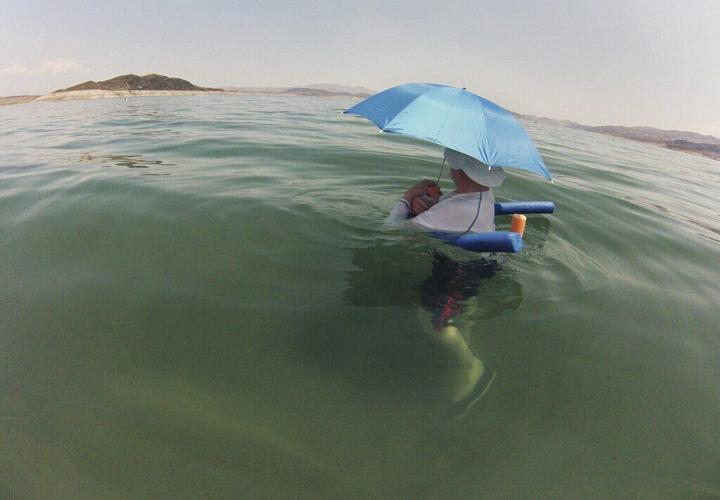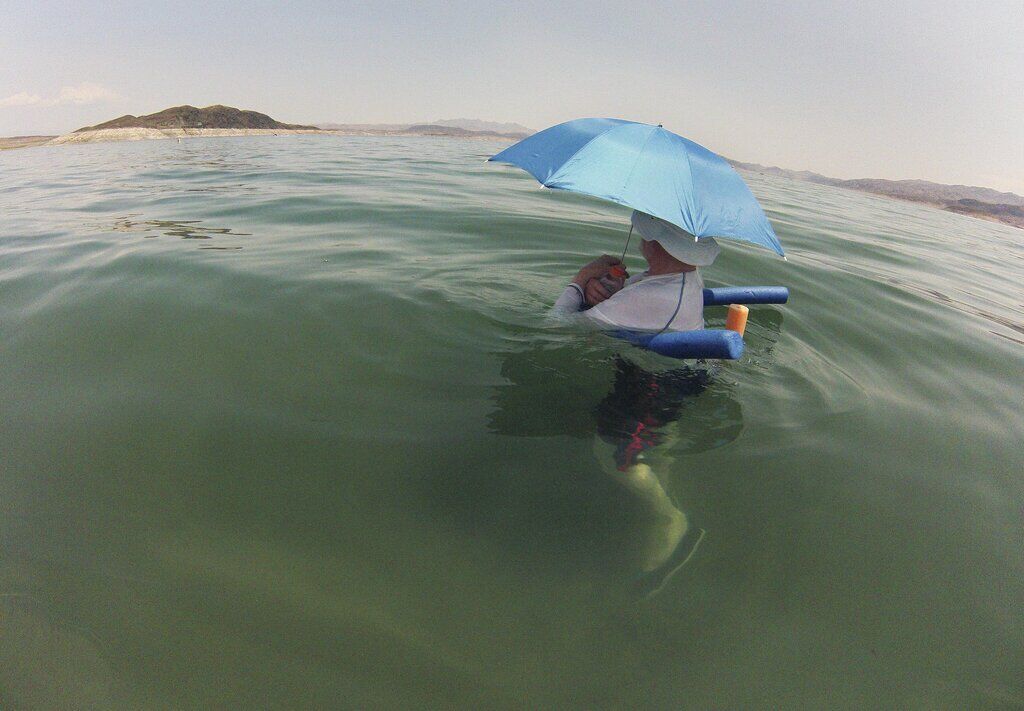Two new studies drive home the dramatic loss of water suffered by the Colorado River Basin this century, in which enough water disappeared from the river system to fill Lake Mead.
One study, written by UCLA scientists, found that the impact of climate change on the river was severe enough that without it, the mandatory federal cutbacks in water deliveries that befell the Southwest in 2022 and 2023 wouldn’t have been needed. Those cutbacks particularly affected Arizona, depriving the Central Arizona Project canal system serving Tucson and Phoenix of more than 20% of its supply last year and about one-third this year.
From 2000-21, the entire river system, spanning seven states and serving 40 million people, lost 32.5 million acre-feet of water due to climate change, the UCLA study said.
That’s the amount of water that would normally have flowed down the river over a similar period but didn’t this century due to climate change, the researchers said. It’s a bit more water than Lake Mead’s total storage capacity of 32.24 million acre-feet.
The second study, led by a Utah State University water researcher, concluded that by themselves, lakes Mead and Powell lost a bit more than that — about 33 million acre-feet — in the same period.
That much water would quench the thirst of all of Arizona’s CAP customers for more than 20 years. It also amounts to enough river water to fulfill the city of Tucson’s annual CAP allocation for well over 220 years.

Due to mandatory federal cutbacks in water deliveries from the stressed Colorado River, the Central Arizona Project canal system serving Tucson and Phoenix lost more than 20% of its supply last year and about one-third this year.
But while the second study didn’t try to pinpoint the impacts of human-caused climate change on the river, it did lay out a path by which the people running the river’s water delivery system could at least stabilize its reservoirs. They are supposed to store water accumulated during wetter years for use during drier years, but continued overuse of river water by people has made our ability to do that increasingly problematic, the second study found.
That study concluded that a cut in total river water use by about 1.5 million acre-feet, or by a range of 13% to 20% annually from current uses, would stabilize the reservoirs’ current low water levels. But if the West experienced another extreme dry period similar to what occurred from 2018-22, for instance, more cuts would likely be needed to protect existing reservoir levels, said retired Utah State University water researcher Jack Schmidt, the study’s lead author.
Actually raising reservoirs to levels significantly higher than today would require deeper cuts of about another 1 million acre-feet a year, the study said.
While this year’s runoff was way above average due to an unusually snowy winter, “Today, the system remains in a vulnerable state, and the 2023 runoff year did not eliminate the jeopardy that we remain in,” Schmidt said.
“If 2024 were to begin another extremely dry spell such as occurred between 2020 and 2022, the reservoir supply would be greatly stressed and there would have to be another round of significant reductions to get through that stress.”
The river’s most immediate problem is “society’s inability to adaptively respond to declining runoff that has been occurring for more than 20 years,” the second study said.
“There is no longer an opportunity to sustain overconsumption” by drawing down the reservoirs “because the reservoirs are nearly empty,” it said.
‘A wakeup call’
It’s been long known that the river is overallocated, and several other studies have also tied its decline since 2000 to global warming triggered by human activities.
In 2019, the three Lower River Basin states — Arizona, California and Nevada — reached an agreement to reduce water use by up to 1.2 million acre-feet a year, depending on how quickly the reservoirs kept falling.
When that agreement, known as the drought contingency plan, proved inadequate, the U.S. Bureau of Reclamation told the basin states a little more than a year ago to cut their water use by up to 28% — 2 million to 4 million acre-feet a year — to prevent the reservoirs from falling so low they would be unable to generate electricity or would fall to “dead pool,” so low they couldn’t deliver water anymore.
This year, the three states approved a scaled-back plan to reduce their use by 13%, after a very wet and snowy winter blessed the river with its highest spring-summer runoff since 2011. But most water experts have agreed the one good winter wasn’t enough to reverse 21 previous years of decline. The states and feds may well approve deeper cuts by 2026, when the river’s current operating guidelines expire.
Underlying the water level declines has been what earlier studies have termed the river’s worst drought in the historical record and perhaps its worst drought since about 1200. The new UCLA study noted that earlier studies have found the years 2020 and 2021 contained the driest 20-month period of precipitation since 1895 and the lowest two years of natural flow from the river’s Upper Basin to the Lower Basin since at least 1906. The study was published in Water Resources Research, a journal run by the American Geophysical Union.
While the lower rainfall since 2000 is primarily caused by natural variability, human-caused warming has aggravated its impact on the river by reducing snowpack, soil moisture and water vapor pressure, the study noted.
Overall, global warming and long-term climate change in general have reduced runoff in the river by nearly 10% since the beginning of this century, the UCLA study found. Looking only at the very severe drought years of 2021 and 2022, runoff then was 38% lower than normal due to climate change, that study concluded.
Using computer-based simulations and historical river and climate data, the UCLA researchers concluded that without the influence of warming and carbon dioxide since the pre-industrial era, annual runoff since 1954 would actually have increased by 4.6%, or nearly 750,000 acre-feet. Instead, the river has lost about 1.7 million acre-feet annually, the researchers said.
Also using computer simulations, the researchers found that the impacts of human-caused warming on the Colorado River Basin have almost been twice as bad as on other Western river basins, including the Columbia River Basin in the Northwest and the Sierra Nevada Basin in California.

Lake Powell near Page. A new study led by a Utah State University water researcher concluded that lakes Mead and Powell lost about 33 million acre-feet from 2000-21, enough water to quench the thirst of all of Arizona’s CAP customers for more than 20 years.
In the extreme drought years of 2020 and 2021, the losses in river flows due to warming weather were three times greater than they would have been otherwise, the researchers found. That’s a key reason they concluded the river water shortages of 2022 wouldn’t have happened without human-caused warming.
The UCLA researchers also used computer models to analyze the countervailing effect that plants have had on flows, by taking in some of the carbon dioxide that could have otherwise aggravated temperature increases and river flow reductions. Without vegetation present, runoff would have dropped in those years by well over 13%, the study said.
Finally, the researchers concluded that areas of the entire river basin that have heavier snowpack were affected far more by warming temperatures than those that don’t.
This is “of immediate concern for water managers because snowpack makes an outsize contribution to the basin’s water supply,” providing two-thirds of the river’s annual runoff even though snowpack areas cover only 30% of the basin’s land, said the American Geophysical Union in announcing the study’s results.
The rapid water loss in snowpack regions is a sign the Rocky Mountain West is transitioning to a more arid climate rather than simply undergoing periodic droughts, said Benjamin Bass, the UCLA study’s lead author, in a news release about the new study.
“The fact that warming removed as much water from the basin as the size of Lake Mead itself during the recent megadrought is a wakeup call to the climate change impacts we are living today,” Bass was quoted as saying.
‘Use has to equal supply’
The study led by Utah State’s Schmidt framed the river’s problems differently.
It said, “The present water crisis has arisen because average basin-wide consumptive uses exceeded the natural supply” throughout this century.
From 2000-20, water use and losses on the river totaled about 15.1 million acre-feet a year, about 1.5 million acre-feet more than the river’s average supply in those years, the study said.
Most of the draining of lakes Powell and Mead in this century occurred in two periods, the study said — first from 2000-07, then from 2020-22.
Less than half the river’s total water use occurs in the four Upper Basin states of Colorado, New Mexico, Utah and Wyoming, and California’s 4.4 million acre-feet of annual river water use almost matches the entire Upper Basin’s consumption, the study said.
In an email, Schmidt noted that today, Powell and Mead hold about 17.8 million acre-feet total, and that all the river’s reservoirs hold 29.5 million.
At the pace the basin states and evaporation took water out of the river from 2016 through 2020, “the total system has only two years of supply” left at that point, the researcher told the Star.
“If not a drop of water flowed into Powell and Mead (in the next two years), and if we didn’t reduce our use, then we would drain the system to dead pool in less than two years,” Schmidt said in a phone interview last week.
“This is not rocket science. It’s checkbook accounting. Use has to equal supply. We would have a buffer if reservoirs were full but the reservoirs are still very low.”
Longtime Arizona Daily Star reporter Tony Davis talks about the viability of seawater desalination and wastewater treatment as alternatives to reliance on the Colorado River.







